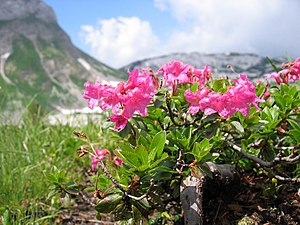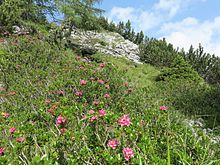Lashed alpine rose
| Lashed alpine rose | ||||||||||||
|---|---|---|---|---|---|---|---|---|---|---|---|---|

Lashed Alpine Rose ( Rhododendron hirsutum ) |
||||||||||||
| Systematics | ||||||||||||
|
||||||||||||
| Scientific name | ||||||||||||
| Rhododendron hirsutum | ||||||||||||
| L. |
The lashed alpine rose ( Rhododendron hirsutum ) is a species of the genus Rhododendron within the heather family (Ericaceae). This well-known alpine plant is also known as alpine rush , alpine rush or stone rose . In the Alps it is - just like the alpenrose - even Almrose called.
description

Vegetative characteristics
The lashed alpine rose is an evergreen shrub with a strong bushy growth and reaches heights of 20 to 100 centimeters. The strong branches and twigs are densely branched. The bark of young twigs is hairy and only slightly scaly.
The alternate leaves arranged on the branches are divided into short petioles and leaf blades. The leathery, simple leaf blade is 1 to 3 centimeters long and up to 1.5 centimeters wide, mostly narrow-elliptical to narrow-inverted. The finely notched to entire leaf margin clearly ciliate, with the horizontally protruding eyelash hairs 1 to 3 millimeters long and quite stiff. The leaf blades are dotted green and glandular on both sides, with the glands initially yellowish, later brownish. The upper side of the leaf is shiny, light green and glabrous.
Generative characteristics
The flowering period is from May to July (rarely until October). At the ends of the branches the flowers are clustered upside down in racemose inflorescences . The flower stalk is about 1.5 inches long.
The flowers have a strikingly strong smell. The hermaphrodite flowers are five-fold with a double flower envelope . The bright red crown is bell-shaped and funnel-shaped with a length and a diameter of up to 1.5 centimeters. It is provided with glandular scales on the outside and hairy on the inside. The stamens are unevenly long and hairy at the base.
The capsule fruits ripen from August. The oval and woody capsule fruits jump open from the top with five flaps and release numerous seeds. The very small seeds are flat, winged and have a loose, light brown seed coat .
The number of chromosomes is 2n = 26.
Ecology and phenology
Although the lashed alpine rose is an alpine plant, it needs a closed snow cover in winter because it is sensitive to frost. The stomata of the foliage leaves move in winds of 1 m / s and close completely even with a good water supply at wind speeds of over 1.5 m / s. As in the case of conifers, the annual course of frost hardness takes place via the adjustment of the osmotic values. The lashed alpine rose can survive under a blanket of snow saturated with water vapor . The eyelashed alpine rose freezes to death in deflated areas. There is an Ericaceous mycorrhiza .
From an ecological point of view, it is a question of the male "bluebells with scattering device". The pollen is floury and comes in tetrads connected by sticky threads. The scars are very slimy. Abundant nectar is released below the ovary, which is covered by the filamentous hairs. Long -nosed bumblebees act as pollinators . Because of the long-haired flower stalks and calyxes, the lightest touch is enough to shake out the pollen. Also a self-pollination is possible. The flowering period extends from May to July.
The five-compartment, wall-fissured capsule fruits open when dry. They are wind and animal spreaders. The seeds are spread out as a granule flyer. The seeds are light germs . The fruit ripening begins in August.
Occurrence
The lashed alpine rose is widespread in the east of the Alps , with a focus on the Northern and Southern Limestone Alps . In the mountain ranges of the Central Alps it can only be found here and there (scattered).
The lashed alpine rose thrives most frequently in lime-rich crooked wood bushes and dwarf shrub heaths . They can also be found on limestone rubble, scree and stony slopes as well as in sparse pine and pine forests. Rhododendron hirsutum is a character species of the Erico-Rhododendretum hirsuti from the Erico-Pinion association. It is a characteristic of the Erico-Rhododendretum (snow heather-alpine rose bushes). The lashed alpine rose thrives at altitudes of 600 to 2500 meters. In the Allgäu Alps, it rises in the Tyrolean part on the Ellbognerspitze up to an altitude of 2480 meters. At low altitudes it occurs mainly in damp ravines, especially in dealpin locations.
The lashed alpine rose is planted outside of its natural range, but is rarely naturalized.
confusion
In contrast to the rust-leaved alpine rose , this species only grows on lime and differs in its leaf eyelashes and the green underside of the leaf. The two species are vicarious .
The hybrid Rhododendron × intermedium ( Rhododendron hirsutum × Rhododendron ferrugineum ) stands morphologically and ecologically between the parents. It occurs particularly frequently in neighboring populations of the parents and usually forms permanent populations. These hybrids are mainly found on soils with an intermediate pH value .
Toxicity
Like many other rhododendron species, the alpine roses are also highly poisonous because of their andromedotoxin (acetylandromedol), which belongs to the diterpenes . Ruminants who eat these plants due to a lack of winter food choices are particularly at risk .
The alpine rose is also poisonous for humans, whereby all parts of the plant (flowers, leaves, fruits and roots) contain the poison Acetylandromedol. Symptoms are increased salivation, nausea, nausea, abdominal pain and diarrhea. At higher doses, severe cardiac arrhythmias, breathing disorders and seizures can occur, which can lead to death due to cardiac arrest and respiratory arrest.
First aid measures are copious intake of fluids and the administration of medical activated charcoal . Further treatments by the doctor follow.
Taxonomy
The first publication of Rhododendron hirsutum was in 1753 by Carl von Linné . The scientific generic name Rhododendron is derived from the Greek "rhodon" for rose and "dendron" for tree. The specific epithet hirsutum is derived from the Latin word for shaggy and refers to the hairy leaves.
literature
- Xaver Finkenzeller, Jürke Grau: Alpine flowers. Recognize and determine (= Steinbach's natural guide ). Mosaik, Munich 2002, ISBN 3-576-11482-3 .
- Manfred A. Fischer, Wolfgang Adler, Karl Oswald: Excursion flora for Austria, Liechtenstein and South Tyrol . 2nd, improved and enlarged edition. State of Upper Austria, Biology Center of the Upper Austrian State Museums, Linz 2005, ISBN 3-85474-140-5 .
- Ruprecht Düll , Herfried Kutzelnigg : Pocket dictionary of plants in Germany and neighboring countries. The most common Central European species in portrait . 7th, corrected and enlarged edition. Quelle & Meyer, Wiebelsheim 2011, ISBN 978-3-494-01424-1 .
- Bruno P. Kremer: Shrub trees. Niedernhausen, 2002. ISBN 3-576-11478-5 .
Individual evidence
- ↑ a b Erich Oberdorfer : Plant-sociological excursion flora for Germany and neighboring areas . With the collaboration of Angelika Schwabe and Theo Müller. 8th, heavily revised and expanded edition. Eugen Ulmer, Stuttgart (Hohenheim) 2001, ISBN 3-8001-3131-5 , pp. 730 .
- ↑ Erhard Dörr, Wolfgang Lippert : Flora of the Allgäu and its surroundings. Volume 2, IHW, Eching 2004, ISBN 3-930167-61-1 , p. 302.
- ↑ Rhododendron, Rosenbaum (Rhododendron ssp.) At www.meb.uni-bonn.de/giftzentrale/ . , accessed June 19, 2011.
Web links
- hirsutum L., Bewimperte Alpenrose & Bewimperte Alpenrose. In: FloraWeb.de.
- Lashed alpine rose . In: BiolFlor, the database of biological-ecological characteristics of the flora of Germany.
- Rhododendron hirsutum L. In: Info Flora , the national data and information center for Swiss flora . Retrieved January 13, 2016.
- Rhododendron hirsutum inthe IUCN 2013 Red List of Threatened Species . Posted by: S. Khela, 2013. Retrieved May 11, 2014.
- Thomas Meyer: Alpenrose data sheet with identification key and photos at Flora-de: Flora von Deutschland (old name of the website: Flowers in Swabia ).
- Gerhard Nitter: Profile with photos.
- Günther Blaich: data sheet with photos.


